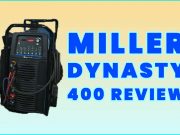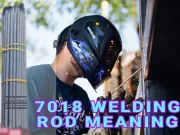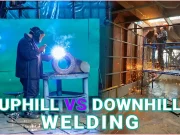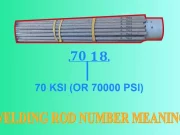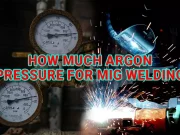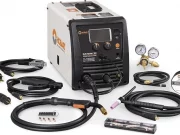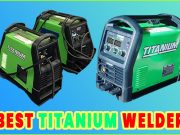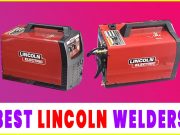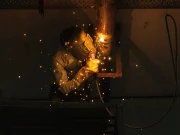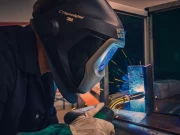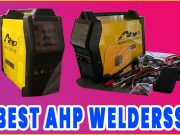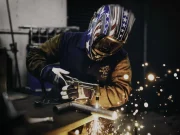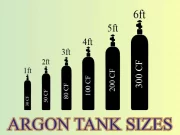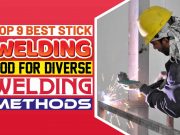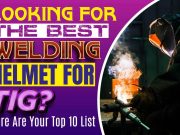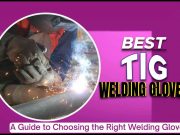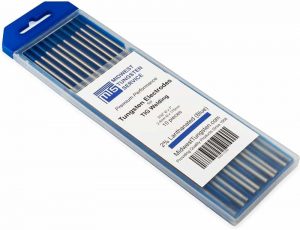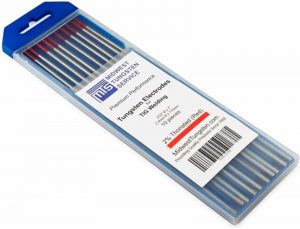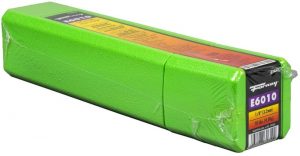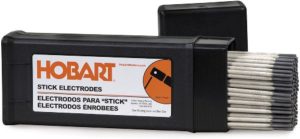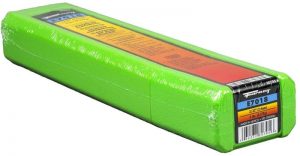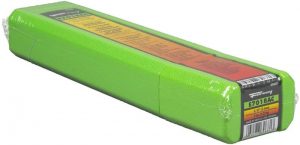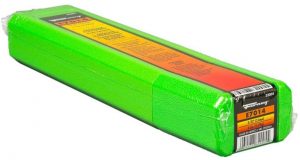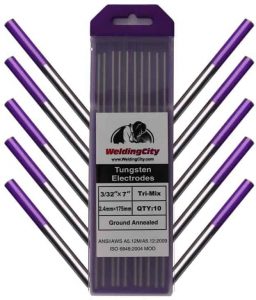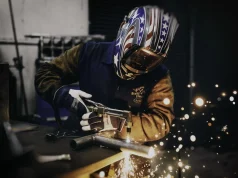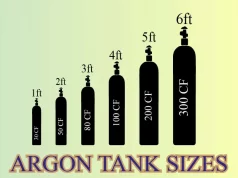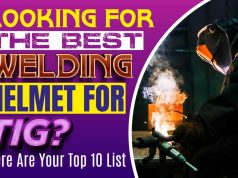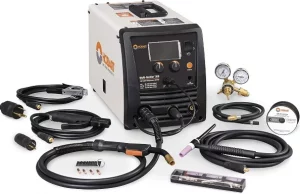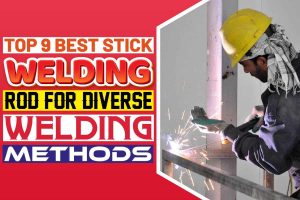
The best stick welding rod, also known as electrode or filler metal performs more than just the joining of two base metals during welding. It should match as many metals as possible, thus improving compatibility and saving money that could be invested in multiple rods. There are basically two types of welding sticks, these are; consumables and non-consumables. The consumable sticks will melt and disintegrate and form a bond that merges two base metals together. Non-consumable rods on the other hand will produce a catalytic reaction with the base metals and create a fusion in an Oxygen-rich environment. The duration of continuous weld will depend on the length of the welding rod.

Top 3 Best Stick Welding Rod
- Size
- Length
- Type
- Current requirement
- Welding position
- Tensile strength
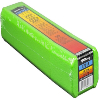
Forney 30705 E7018 Welding Rod
- 1/8”
- 14.63”
- Thoriated
- 105 amps AC/DC
- All-welding positions
- 85,000
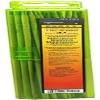
Forney 31101 E6011 Welding Rod
- 3/32”
- 15.25”
- Thoriated
- 90 amps
- All-welding position
- 60,000 PSI
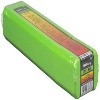
Forney 30681 E7018 Welding Rod
- 3/32”
- 15.25”
- Thoriated
- 110 Amps AC/DC
- All-welding position
- 70.000 PSI
Review Of Top 9 Welding Sticks
Based on performance, general acceptance, and tests conducted on many sticks welder rods, the following are considered to be the top options;
1. TIG Welding Tungsten Electrodes
This tungsten welding product is a premium TIG welding rod that provides lasting welding results.
Specifications
- 2% EWLA Lanthanated
- Blue color
- 10-pack
- 3/32”
- Tungsten electrodes
- Measures 8.07 x 2.28 x 0.28 inches
- 5.9 ounces
Features
These TIG welding tungsten electrodes offer reliable welding under different conditions. The rods have been engineered to the exact specifications; hence they can perform even under the most demanding welding applications.
They come with very reliable arc-striking features with low burn-off rates. These electrodes will maintain the highest arc quality because they maintain their AWS and ANSI ratings or certifications. Lanthanated electrodes are particularly popular because they strike an arc quickly under lower amperage.
The 2% Lanthanated blue electrodes will perform very well in both AC and DC applications. They are also ideal for welding aluminum, magnesium alloys, nickel alloys, copper alloys, Titanium alloys, alloy steels, and stainless steel.
This product is one of the highest-rated options for welders. It is manufactured in the US but sold worldwide and also comes with online customer service. The product comes with a limited manufacturer warranty.
The significant thickness of these rods makes them last longer. You can use time over and over again before they are used up. The tungsten rods are built with some resistance to weather conditions, though they still need to be stored inside their customized package.
The product comes with a certificate of conformance in addition to the ANSI and AWS certifications. The tungsten rods also come with a more stable arc than the regular tungsten because of the coating on the outer body.
Pros
- It comes with Well-organized storage
- Long-lasting electrodes
- Low burn-off rates
- Strikes an arc quickly under low amperage
- Applicable to welding diverse metals
- It works under AC and DC currents
Cons
- Primarily suitable for welding thinner metals
2. TIG Welding Tungsten Electrodes
These thoriated tungsten rods will rival other professional welding rods on this list. Even the premium package shows how serious the manufacturers are.
Specifications
- 2% Thoriated tungsten rods
- 10-pack rods
- Red color
- WT20 rating
- 3/32” size
- Weighs 6.4 ounces
- Measures 7.9 x 2.3 x 0.1 inches
- Made from Tungsten material
- 7” length
Features
In addition to the regular 3/32” size, this rod also comes in the 1/16” size; hence you can choose either of the two depending on your welding needs. The premium rods come in a premium pack for safe-keeping and protection from moisture and dust.
The thoriated rods have been coated to ensure an extension of the rod’s lifespan. The highest-rated rod belongs to the class of the most reviewed welding rods. The rods are manufactured in the United States, but the customer care services are available online.
You can use several materials to sharpen these tungsten rods without destroying them. You can use a handheld grinder, belt sander, or bench grinder to sharpen the tungsten rods. Professional and beginner welders can use the rods in welding Nickel alloys, Titanium alloys, copper alloys, and stainless steel.
Thoriated tungsten rods are known for very reliable arc-striking properties. They also produce a meager burn-off rate and retain their durability. They perform primarily in DC applications, but they still require low amperage to weld metals. They can adapt to challenging welding applications as long as you are welding the recommended metal.
This product comes with a manufacturer warranty for peace of mind, but you need to avoid imitations and buy from recommended stores only. It comes with the Standard America Welding Society certification for quality.
Pros
- Thoriated coating for extra durability
- Compatible with many metals
- Excellent arc striking
- Reliable and long-lasting
- Affordable
Cons
- Recommended for DC only
3. 31610 E6010 Welding Rod, 1/8-Inch
This excellent rod is an all-position welding rod that delivers a perfect welding job.
Specifications
- All position welding rod
- DC/AC welding rod
- 4.61 lbs. weight
- 60,000 PSI strength
- 65-130 amperage
- Grey color
- Package measures 14.63 x 4.38 x 2.25 inches
- 90-day manufacturer warranty
- 1/8-inch thickness
Features
This is an all-position welding rod that comes with a digging arc. It is capable of producing a deeper penetration even through dirty, rusty, and painted metal materials. The rod is also suitable for welding complex joints and other areas that require deeper penetration, like square edge butt.
The rod is excellent for vertical and overhead welding and produces minimal slag. With this device, you only need a very minimal surface preparation of base metal. It is also recommended for vertical and overhead welding with minimal slag.
The rods are great for welding galvanized steel and the maintenance and repair of rusty or oily steel. You can also use it for pipe welding. The rod runs on a DCEP technology, also known as reversed-polarity. The rods also come with low-hydrogen and iron powder, and these features add to their acceptable welding results.
You can use the AC option for medium penetration of the rod, and the positive DC power option is excellent for deeper penetration. You need to present your proof of purchase if claiming the product warranty. The product warranty does not cover negligence or accidents on your part. The company offers one of the best customer care supports online. Warranty can only be claimed when you purchase this product directly from the manufacturer or recommended vendor.
Pros
- Deeper penetration
- High tensile strength
- All position digging rod
- Suitable for difficult welding at metal joints
- Minimal metal surface preparation required
- Wider applications
Cons
- Flux coating can be extra-thick
4. Hobart 770470 6013 Stick
If you want to save money by purchasing so many rods simultaneously, then this should be your choice.
Specifications
- More than 20 rods in a pack
- 1/8-inch thickness
- White and black colors
- 10 lbs. weight
- Light to medium penetration
- 60,000 PSI tensile strength
- AC/DC power operations
- Measures 14.5 x 4.4 x 2.3 inches
Features
This welding rod is available in three different options, which are 5lbs, 10lbs, and 25 lbs. It offers light to medium penetration depending on the application and whether you use AC or DC operational mode. It runs on the AC or the reversed polarity DCEP or straight polarity DCEN options.
This fantastic device is an all-purpose or all-position stick electrode that works in all positions. You can use it in welding carbon, steel, and a wide range of other lighter metals. With a tensile strength of up to 60000 PSI, You can apply it for general welding. The high tensile strength also makes each rod last longer.
With dozens of rods in one pack, you can save lots of money on this product and use the rods for a more extended period. The rod can weld those metal joints successfully with poor fit-up. Metals will require a little cleaning before welding, and these rods welds rough and dirty metal surfaces efficiently.
Though the rods are excellent quality, the warranty only covers original rods for 1-month parts and labor. The product will require storage in a cool, dry place at room temperature to prevent moisture buildup around them.
Pros
- Available in diverse sizes
- More than a dozen rods in one pack
- High tensile strength for extra durability
- Budget-friendly
- Great for poor metal joints
Cons
- Warranty only covers one month of parts and labor
5. Forney 30705 E7018 Welding Rod
Another reliable stick welding rod from the reputable Forney manufacturer. This product is available in three sizes; hence you can find one that matches your welding needs.
Specifications
- Available in 1/8”, 3/32” and 5/32”
- Available in 1lb. 5 lb. and 10 lb. weights
- AC/DC+ applications
- Low hydrogen needs
- 5 lbs. weight
- Measures 14.63 x 3.5 x 1.75 inches
- Grey color
- Mild steel construction
- 105 Amps
- Arc welding installation
- 90-day warranty
- DCEP reverse or AC polarities
- 84,000 PSI tensile strength
Features
This is one of the best stick welding rods in the market because it produces satisfactory results with smaller amperage on DC or higher amperage on AC welders.
It is also suitable for just all positions, including the hard-enabled steel where no pre-heating is necessary. Professional and beginner welders can also apply it on the cold roll steel that shows excessive porosity when welded with the traditional rods.
It comes with a very low hydrogen content that reduces the risks of cracking and peeling of weld materials. Beginner and professional welders can use it for field erections and correcting field structures, frames, trailer hitches, and chassis.
The recommended polarity for this is DCEP (reverse) or AC, depending on the application. AC application will require the higher amperage, and DC reverse will require lower amperage for welding. With a tensile strength of 84,000 PSI, this is one of the most robust welding sticks for welding on the market.
The easy-to0se welding rod maintains a stable arc during welding. All-position welding can apply to low-penetration AC welding and can also be used on DC+ welding. It is designed for head-enabled steel welding, plus projects that require welding hard steels. Thick sections and restraint joints with cracking problems can also be welded successfully with this rod.
It is excellent for tack welds and out-of-position metal welding. It can also be an ideal option for the fabrication of cold roll steels.
Pros
- Multiple sizes and weights
- Very easy to use
- Low hydrogen
- Multiple applications
- AC/DC applications
Cons
- It is not recommended for Open Circuit Voltage (OCV) power
6. Forney 30681 E7018 AC Welding Rod
Easy-to-use welding rod for a wide range of applications.
Specifications
- 3/32” size
- 5 lbs. weight
- All-welding position rod
- Low hydrogen component
- Low penetration AC application and DC+
- OCV power source compatible
- Measures 15.25 x 7.75 x 4.5 inches
- Grey color
- Mild steel construction
- Arc welding installation
- 110 amps
- 70,000 TSI
- 90-day manufacturer warranty
Features
As expected from any Forney rod, this product does not fail to deliver. It comes in three different weights and thickness sizes; hence you can choose the most suitable for your needs. In addition to the 5lbs. and 3/32” size, you can find it also in 1/8” and 5/32” sizes and 1lb. and 10 lb. sizes.
The easy-to-use weld rod is suitable for all-position welding. It comes with minimal hydrogen components for cleaner welds. It works perfectly well for low-penetration AC welding and DC+ applications.
This welding stick is excellent for excellent bead contour, and it is also offering a self-cleaning effect on your weld, thus reducing the risks of splatter and slag. It provides outstanding performance even with the low open-circuit OCV power usage.
This welding stick is suitable for out-of-position welding. It is an excellent option for tack and skips welds. Similarly, it produces an easy re-striking, which helps you perfect your final welding results. Metallic product manufacturers, shop owners, hobbyists, and home DIY welders can rely on this welding stick for the best results.
This product is manufactured in the USA and comes with a 90-day warranty covering product defects and labor costs.
Pros
- Very low hydrogen content
- Works with OCV power sources
- More powerful tensile strength
- Wide applications
- Very easy to use
Cons
- It can become too sensitive to amperage
7. Forney 32005 E7014 Welding Rod
This affordable welding rod comes in a handy pack, and it delivers great welding results, just as great as others on the list.
Specifications
- 3/32” size
- 5 lbs. weight
- All-position welding
- Measures 14.63 x 3.5 x 1.75 inches
- Grey color
- Mild steel body construction
- 90 amps
- 70,000 Tensile strengths
- 90-day warranty
- AC/DC+ welding
Features
This device is an easy-to-use welding stick rated as E7014, which means it will create a smooth arc and low spatter for most steel welding. This feature helps you get a cleaner final result.
As an all-position welding rod, handling the stick should pose no problem. It also comes with a digging arc and deep penetration even on dirty, rusty, and painted metal surfaces. You need very minimal cleaning on the base metal to start using this rod.
This rod is recommended for welding joints requiring deeper penetration, such as the square edge butt welds. It is also a perfect choice for vertical and overhead welding with minimal slag.
The welding stick is recommended for galvanized steel and oily and rusty steel. This stick is also suitable for maintenance repair applications and pipe welding.
Though it comes with high tensile strength and durability, this rod will still require storage in dry conditions under room temperature. The product comes with a 90-day manufacturer warranty that covers defective parts from the manufacturer.
Pros
- Versatile for diverse applications
- All-position welding
- Lightweight
- High tensile strength and durability
- Very easy to use and maneuver
- Smooth arc and low spatter
- Affordable
Cons
- You may need some time to dry out the damp rods
8. WeldingCity 10-pcs TIG Welding Tungsten Electrode
This welding rod option is a unique 10-pack TIG welding electrode that does not fail to deliver.
Specifications
- 10-rod pieces in a pack
- Tungsten electrode
- Tri-element non-radioactive
- Purple color
- 3/32” size
- 7-inch Length
- Mixed trioxide coating
- 2% Thoriated
- 2 oz. weight
- Tungsten body material
- Measures 7 x 4 x 0.25 inches
Features
In addition to the 3/32” thickness or size, this rod is also available in 1/8”, 1/16”, and 5/32”, allowing you to match your welding with the correct dimensions. The purple EWG welding rod is a tri-element tungsten electrode which means it comes with some components of three rare earth metals. It is non-radioactive; hence it is very safe for the environment.
The rod is built to meet the ANSI and AWS standards for quality and safety. The rod has between 1.5 and 1.8 components of Lanthanum, Zirconium, and Yttrium rare earth metals. The Tungsten electrode is thoriated to enhance its performance and resist some adverse damaging environmental conditions.
In addition to its low burn rate and more comprehensive current application, this rod comes with an excellent arc start and maintains its arc stability during welding. The manufacturer offers a buy more save more promotion; hence you can save lots of money on the product.
The USA-based manufacturer provides technical support for genuine products only. The product also comes with a 90-day manufacturer warranty on any defect caused by the manufacturer.
Pros
- Wider current range
- It has a meager burn-off rate
- Handle varieties of thick and thin metals
- Available in varieties of other sizes
- Easy arc starts and good arc stability
Cons
- The package needs bubble wrap to prevent breakages
9. Forney 31101 E6011 Welding Rod
This viable welding rod is an all-position welding rod for precise and accurate welding.
Specifications
- 3/32”
- 1 lb.
- 6011 weld rod
- All-purpose or all-position welding
- Smooth arc
- AC and DC+ welding
- It measures 15.25 x 0.75 x 1.63
- Grey color
- Steel body construction
- 90 amps
- 60,000 tensile strengths
- 90-day manufacturer warranty
- AC/DC operations
Features
The rod comes in a brand-new package, and it is categorized as an E6011 rod which means it is an all-position rod that can penetrate deeper into steel. The easy-to-use rod not only penetrates deep through dirty, painted, and rusty metal, it can also create fast-freezing or fast-welding on the metal.
This welding rod penetrates deep into rough metal surfaces with ease. It creates a smooth arc wetting effect alongside a good spread with incredible splatter, thus creating faster deposition. It also establishes some flatter contour fillets with excellent travel speed. It would be best if you had a very minimal base metal surface preparation before welding.
It is an excellent option for tough metals like galvanized steel and rusty steel. It can offer superior performance for repairs and metal fabrications. It is reliable for low amperage AC and higher amperage DC operations without compromising on quality.
Aside from professional welders who fabricate and repair metals, DIY home welders and beginners can also use the welding rod efficiently.
Pros
- Very easy to handle
- Very smooth arc feature
- High tensile strength
- Wide application
- Cheaper than similar products
Cons
- It can be too sensitive to amperage changes and burn fast
Top 9 Best Stick Welding Rods- What To Consider To Make The Right Choice
Finding the right welding stick for your welding needs should not be based on cost only. It would be best if you considered even more critical factors, including the following;
- Length
- Tensile strength
- Ductility
- Design Materials
- Weld position
- Polarity
- Thickness
- Quantity and Costs
- Other Factors
- Length of Welding Stick
One of the essential features of a welding stick you must consider when making your final choice is the Lengthof the stick. Since a welding stick is consumable, it is expected for longer rods to last longer than shorter ones because they take a longer time to burn off. This does not mean that longer rods are always the best; you still have to consider several other features. It would be best to think that longer rods may cost more than shorter ones of the exact quantities.
1. Tensile Strength
Tensile strength is another factor you must consider when choosing a welding rod. Simply put, tensile strength is the resistance of a material to breaking under pressure or tension. In most cases, welding sticks that come with 60,000 or higher figures are the best for welding.
The higher the tensile strength, the more the durability and longevity. This popular notion means sticks with more challenging designs will save you more money in the long run, and you don’t have to replace them too frequently like those with lower strength. You can identify the tensile strength of a welding rod from its code. For instance, a welding rod with code 10001 means 100,000 tensile strength, while E6010 means 60,000 tensile strength.
2. Ductility of The Rod
The ductility of a rod is the ability to be welded successfully into a base metal. Welding sticks don’t have the same ductility, and as a result, they are classified under specific codes. Ductility also depends on the compatibility with a base metal. Some rods have higher ductility for certain metals than others.
The Lanthanated blue welding sticks, for instance, are more compatible with Aluminum alloys, magnesium alloys, copper alloys, nickel alloys, titanium alloys, stainless steel, and low-alloyed steel. You need to match your welding rods.
3. The Design Materials
Today, Tungsten body rods are more common as welding rods than other types. When looking for your welding rods, you may want to go for coated tungsten materials because they melt slowly, reduce slags and give a cleaner weld.
Stainless steel electrodes can suffer from several problems. They may suffer from frequent sticking, and the slags will crack upon the cooling of the welded base metal. You should only consider these electrodes when welding mixed materials like stainless steel and iron or stainless steel with hard steel.
Cast Iron electrodes tend to be more sensitive than other types of welding sticks. Welders must handle them with special care. Cast iron electrodes must be pre-heated before they are used and, in the process, take a longer time to use. You will also need to cool the parts of the rod slowly to prevent cracking after welding.
4. The Weld Position
The weld position is as important as any other factor when choosing the ideal welding rods. The all-direction rod is always the best choice when it comes to welding position for rod because it is versatile and can be used in all positions.
There are three other positions in addition to the all-direction welding rod: Cornice, vertical and overhead. The Cornice position rod is a vertical rod that welds the base material horizontally. The Vertical position rod is the one that can weld upward or downward.
The overhead position rod is the one that seems to be the hardest for most welders because you have to be under the welded material. Overhead position rods are primarily used in welding floor plans or chassis.
5. Thickness of Rod
You must pay attention to the thickness of the rod because it plays a crucial role in determining what you use the rod to weld. While rods with diameters of 1/8” can be used un welding metals that are up t0 3mm in thickness, you may need rods of up to 5/32” or more to weld materials that are thicker than 3mm.
You may need to add even more fillers to some metals to weld to the core. In a case of overlapping and angled weds, you may start welding with rods of smaller thickness to fill the corner roughly and then complete welding with rods of thicker diameter.
Make sure you match your welding needs with the appropriate thickness of rods. Generally, the thicker the rod, the less it burns off and the longer it lasts.
6. Polarity
Simply put, polarity is the electrical connection type that is compatible with the welding stick’s clamp. With the polarity of your rod known, you can plug the clamp into the negative or positive current ends.
Connectors can be identical, and the positive electrode comes with the DC+ polarity while the negative electrode comes with DC-. While some welding rods can operate only with the AC, the better options work with both AC and DC polarity. For thinner metals that require higher amperage, you will need the AC, and for stricter metals like stainless steel, you will need DC+ welding.
7. Quantity and Cost
Welding rods are generally affordable, but several factors can determine costs. The thicker the rod, the costlier it becomes. Similarly, the more quantity included in the package, the more expensive the rods may be. Other factors such as the type of coating may also increase prices sharply.
Experts recommend that you buy a pack of rods containing ten or more rods. The more the number of rods included in a pack, the longer you can use them and the more money you will save in the long run.
8. Other Factors
Other factors you may want to consider when choosing suitable welding rods may include application varieties and the weight of the rod. The wider the application, the better the rod. A welder who welds diverse base metals will consider rods versatile and widely usable in many ways. You need to look at your personal welding needs before finding the appropriate rods that match them.
The weight of the rod may not be a significant factor to consider, except you want to look at convenience when welding. The weightier the rod, the more energy you need to hold and adjust the position during welding.
Best Stick Welding Sticks – Frequently Asked Questions (FAQ)
The following are some of the most frequently asked questions and answers on stick welding rods.
Question: What are the Significances of Thoriation, Lanthanation, and Other Treatments for Welding Rods?
Answer: Many great benefits come with the processing methods, such as coating used on welding sticks. They can also help you identify what rod is compatible with the welding of different types of metals. 2% thoriated rods marked red color are compatible only with DC polarity and are more consistent with welding copper alloys, nickel alloys, stainless steel, and titanium alloys.
2% Lanthanated welding sticks are compatible with AC/DC polarity and can be used primarily on welding Aluminum alloys, copper alloys, magnesium alloys, nickel alloys, stainless steel, and low-alloyed steel. The pure tungsten welding sticks are suitable for AC polarity welding only but are compatible with magnesium alloys and aluminum alloys.
The 2% Ceriated grey colored welding sticks are compatible with AC and DC welding. Beginner, intermediate and professional welders, can use the rods in welding copper alloys, titanium alloys, magnesium alloys, aluminum alloys, stainless steel, low-alloy steels, and nickel alloys.
The 1% Lanthanated welding sticks, identified with yellow color, are compatible with AC and DC welding. These welding sticks are great for welding Copper alloys, Titanium alloys, Nickel alloys, and stainless steel.
The Rare earth blend, which comprises rare earth metal rods, is classified with the purple color. These rods are compatible with AC and DC welding. The rods are great in welding-based metals such as; Magnesium alloys, aluminum alloys, nickel alloys, titanium alloys, copper alloys, stainless steel, and low-alloyed steels.
The 0.8% Zirconated rods come in white color. These rods are only suitable for AC welding and are compatible with welding higher amps welding for magnesium.
Question: What function does the Flux surrounding the welding stick serve?
Answer: All welding sticks consist of rods surrounded by flux coating; these coatings serve various purposes. The coating dictates where and how You should use the rods.
When you strike an arc, the Flux will automatically burn and generate several chemical reactions. While the rod’s components burn within the welding arc, shielding gas releases that protect the weld pool from external impurities.
Once the weld pool cools, the welding flux will form a slag to protect the weld metal from oxidation and porosity in your weld bead. Flux is also known for its ionizing elements that will make your weld arc more stable. Some weld sticks will combine Flux with a high concentration of iron powder to increase deposition rates.
Question: When should I use a high deposition welding stick electrode?
Answer: Welding sticks with high deposition rates can make your welding jobs faster, but they have limitations. There is also higher iron powder inside the high deposition welding stick, and its presence will make the weld pool more fluid. It also means that high deposition welding rods should not be used for dis-jointed metal welding applications.
High deposition welding rods can also not be used for code-required metal welding applications. Boiler metal fabrication, for instance, and bead welding, for example, are susceptible to high stress; hence high-deposition rods should not be used for such.
Fortunately, high deposition rods can be the best option for non-coded applications. For instance, you can use them for welding storage tanks and non-structural metals.
Question: What are the main differences between Welding rods E7014, E7018, and E7024?
Answer: There are differences in welding rods E7014, E7018, and E7024, and they can be used in different ways. E7014 produces penetration similar to the E6012 and is designed to weld carbon and low alloy steels. They do contain a high amount of iron powder, and that means higher deposition rates. For this reason, E7014 can be used with higher amperages for welding.
The E7018 comes with thick Flux and significantly high iron powder components. They are much easier to use than the 7014 because they produce a smoother and quieter arc. The rods will generate minimal splatter while producing medium penetration.
Many welders use these rods to weld the thicker base metals like structural steel. These rods produce strong welds alongside high-impact properties, even in cold weather. You can use them in high welding carbon, carbon steel, high-strength steel, and low alloy metals.
The E7024 rods come with high levels of iron powder, which will increase deposition rates. Most welders who rely on the E7024 use this for fast horizontal and flat fillet welds. These rods will perform much better on steel plates, especially those at least ¼” thick.
Question: What is the best way to store and re-dry your welding stick?
Answer: The best storage environment for your welding rods is a low-humidity and dry one. If possible, you should consider heating the environment. For instance, the mild steel with a low hydrogen component will be stored at a temperature range of between 250F and 300F degrees.
Though room temperature may be okay if the rods are kept inside their packages, it will be better to make the environment water. Reconditioning storage temperatures to about 600F degrees for about 2 hours will help recondition. Welding rods like E6011 can still store well at a relative humidity of up to 70% and a temperature range of between 40 and 120F degrees.
It would be best to refer to the manufacturer manual to learn more about storing your welding stick.
Tips To Increase Your Welding Techniques
There are some essential elements of your welding that you need to improve to get the most out of your stick welding;
1. Always Re-adjust the CLAMS
CLAMS, an acronym of Current setting, Length of arc, Angle of the electrode, Manipulation of electrode and speed of travel. If you weld different metals, you should check these settings always before you weld a new metal. This should become your second nature as a welder because it can save you a lot of trouble and get you the best results.
2. Use Glob or Spray Modes for Thicker Steels
Adjusting Voltage, amps and rod welding speed can ensure transfer modes fine-tuned itself to weld thick metals. The limitation of using the globular or spray mode is that it can be used only to weld metals of 1/8” and thicker. It can also be used for horizontal and flat fillet welds. .
The globular transfer mode, also referred to as “Short arc”, involves the increase of the voltage, amp and feed speeder. This will lead to the creation of large globs and expels the end of the wire faster to provide deeper penetration of welds. This means faster welding and cleaner results but more splatter may be generated.
In the spray arc transfer, you may have to increase the volt, amp and wire-speed even more than in the globular transfer. This will generate some tiny molten droplets that will be sprayed across the arc created from your wire to the metal. Spray arc works with larger diameter wire, hence lots of metals will be deposited. You will be able to achieve better looking beads with this option. This option can also be used with horizontal or flat fillet weld, and you should change the nozzle to a 3-inch or longer option.
3. Always Try to Clean Out Impurities
Though there are welding rods that can weld an irregular metal surface that is rusty and dirty, it still pays to remove as many impurities as you can.
Sometimes you may have to grind out the cracks in addition to removing paints, dirt, rust and other surface impurities. Wire brush for instance can remove the dirt and stains. Removing impurities will prevent them from being absorbed during welding. Impurities can compromise repair welding, for instance.
Make sure hydrogen is reduced in your weld materials, too, because it is present everywhere, even in dirt, grease, stains, paints, and other common impurities. Cleaning your weld metal base can help whittle down hydrogen to ensure your wedding goes smooth and produce great results.
4. Improve Work Angle and Arc Spacing
For the work angle, you should hold the gun between 10 and 15 degrees for wire welding and at the direction you push your weld. For stick welding, you should maintain an angle of between 20 and 30 degrees. This angle must be maintained at the dragging direction.
For the arc spacing, you must adjust your travel speed so that your welding arc stays within a third of the weld pool. Always maintain a distance of between 3/8 and 1/2inch for your wire welding. For your stick welding, you should maintain a distance of 1/8” between the rod tip and the base metal.
Conclusion
This product review and guide has shown that the most important thing to consider when looking for the best stick welding rod is your personal needs. Without considering your personal needs, you will end up choosing the right welding stick for the wrong purpose. You need to study the thickness of the base metals you will weld before choosing the appropriate rod weight you can handle without causing strain on your hands. In whatever situation you find yourself, you should never prioritize costs over rod quality. You should be flexible with your budget when you find comparable products of similar features but price differences.

